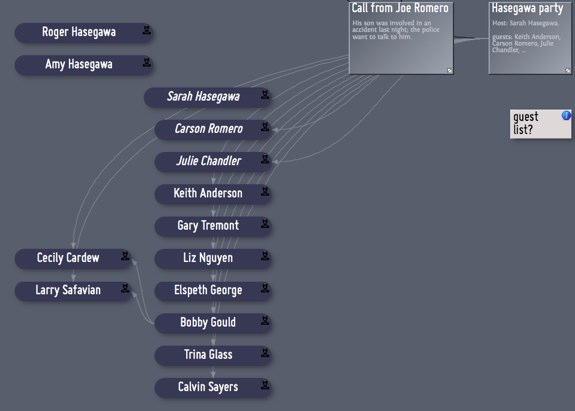Episode 5
Party List
What Happened
Story outline: actual text to follow
- We obtain guest list for the from the Hasegawas.
- Nine students, including host Janet Hasegawa, our client Carson Romero, and Julie Chandler were at the party.
- Janet’s parents, Roger and Amy Hasegawa, were in the house during the party.
- Most of the guests are classmates of Janet’s at Bellvale High. Keith Anderson and Calvin Sayers are freshmen at Wellington University, but previously attended Bellvale High.
- One of the attendees, Bobby Gould, recalled two guests who were not on the list the Hasegawa’s supplied. Both are students at a Wellington.
Previously in The Romero File

How We Map It
First, Tinderbox gives us a place to write things down – even things that might prove unimportant. Here, we can quickly jot down the guest list for the party that Carson and Julie were both attending before the accidents.
We already have made notes about Julie Chandler and Carson Romero. Instead of making additional notes, we can make aliases for the existing notes and place them with the other guests. The alias is, in almost all respects, interchangeable for the original note; when we add text to the note, for example, both the original and the alias are updated automatically.
Tinderbox timestamps each note automatically. It’s not likely that we’ll ever need to know at what time we spoke with Bobby Gould, a senior at Bellvale High, but if that eventually becomes useful to know, we’ve got the information. If we want to insert timestamps into the text, they’re just a keystroke (cmd-/) away.
It’s also easy to keep notes connected. Here, we’ve defined a new link type, “party’, which appears as a light gray line.
Bobby Gould mentioned two people at the party who Janet didn’t tell us about, Larry Safavian and his girlfriend Cecily Cardew. We can use links to note that their presence at the party was sourced to Mr. Gould.
R&D
Tinderbox offers many different ways to represent relationships among notes. Instead of linking the party to the guests, we might have linked each guest to the party. Or, we might have “tagged” each guest as a PartyGuest. We might have an attribute “Guest” which is true for people who were at the party. We might have a container to hold all the guests at the party.
Which way is best? It depends! In practice, because you don’t know how you will need to use notes, it can be difficult to decide the best way to represent relationships. Tinderbox makes it easy to choose one representation, and then recast your notes to use a new representation when circumstances change.
Perhaps the most important intellectual contribution of computer science generally, and AI specifically, to intellectual culture has been the recognition of the central importance of representation. Choosing how we represent and encode a concept or a fact often seems to make the difference between intractable confusion and simple, obvious solutions.


